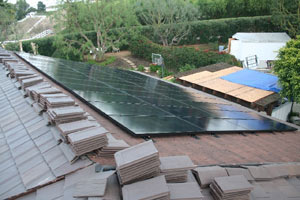Residential solar may reach grid parity in California in 2015
 California is the nation’s largest solar market in the nation, thanks to its incentives and rebates, which include a 33 percent renewable energy standard and the Million Solar Roofs programs.
California is the nation’s largest solar market in the nation, thanks to its incentives and rebates, which include a 33 percent renewable energy standard and the Million Solar Roofs programs.
And with a number of the largest solar projects in the world planned to start supplying utilities with power beginning to come online (at least partially) this year, it’s no wonder that the market has reduced prices to near grid parity levels. But now some are saying the cost of residential solar could reach grid parity by as early as mid-2014.
Environment California’s Research & Policy Center estimated that when the price of installed solar falls to $5.25 per watt, without rebates, that it will have reached grid parity in the market.
“If progress continues at the same rate it has over the past four years, residential prices will reach this cost-competitive position without rebates in mid-2014. Outside investment analysts place this milestone at around 2016,” the center said in its recent report, Building a Brighter Future.
“It’s sort of our prognosis,” said Bernadette Del Chiaro, director of Clean Energy and Global Warming Programs Environment California. “It could be wrong; policy makers could change the roads we’re on.”
But based on current progress on the Million Solar Roofs Initiative and policy, the state is likely to hit that important milestone in the next few years.
“It assumes the rebates are phased out but that we still have net metering,” Del Chiaro said.
However, if there are challenges to net-metering rules or the legislature changes net-metering, it could impact when the threshold for parity is reached.
Such policies could include San Diego Gas & Electric’s plan to charge residential solar owners $10 to $40 a month for energy transportation costs, according to Environment California. That could raise a solar homeowner’s electric bill by up to 90 percent the organization said in its California Solar Cities 2012 report.
Beyond policy, a driving factor behind the lowering cost of installed residential solar in California from $10.69 per watt in January 2007—when initiative began—to $6.31 p/W in August 2011 was the falling price of PV modules.
At this point, modules make up about 40 percent of the cost of the system with the balance-of-systems costs making up the rest. Another thing that has helped reduce the costs is the spread of third-party ownership options in the state, which allows homeowners to go solar with no upfront costs.
To help speed residential solar toward grid parity, the state must ensure that the net-metering policies remain in place and should work to standardize procedures and minimize fees while streamlining the permitting process, Environment California said.
Image courtesy of Go California.



